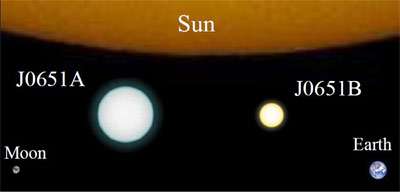White dwarfs' tidal effects may create novae, study says

(Phys.org)—Theoretical physicists at Cornell may have found a new way to explain the formation of novae, stars that suddenly become very bright then quickly fade.
At the heart of the theory is a pair of old, dense stars called white dwarfs, orbiting each other so closely that their gravitational forces create violent tidal waves of plasma that break near the surfaces of the stars. The phenomenon is what the researchers have dubbed a tidally induced nova.
If their theory is correct, it would represent a big step forward for astrophysics, said lead researcher Jim Fuller, a Ph.D. candidate in the field of astronomy and space sciences. "It's an important problem because there are a lot of white dwarfs in tight binaries," said Fuller, who co-wrote the study with Dong Lai, professor of astronomy. "They're spiraling in toward each other, so tidal effects are going to be very important, but no one has really studied that."
The types of white dwarfs Fuller and Lai have been researching orbit each other very quickly, in less than half an hour. Because white dwarfs are so dense, their gravitational forces are strong enough to pull the stars toward each other in an increasingly tighter spiral. The forces deform the stars, squishing each sphere into an oval, as well as synchronizing them so they spin at the same rate as they orbit and causing enormous gaseous tidal waves. The friction caused by the tidal forces also generates enormous heat, potentially more heat than the sun emits.
Fuller and Lai theorize that the heat is deposited at the thin layer of hydrogen that coats a white dwarf. Hydrogen makes up only 0.01 percent of a white dwarf's mass. But hydrogen is volatile, and heat generated from the tidal friction is enough to spark a fusion reaction. That heat in turn sparks further reactions, triggering in effect a series of exploding atomic bombs. "Those reactions accelerate until all the hydrogen burns off very quickly, and that's a tidally induced nova," Fuller said.
The nova eventually flames out, and the white dwarfs continue to orbit and spiral in toward each other over time.
It may take awhile to prove the theory is correct. White dwarfs are notoriously dim and hard to see. Tidally induced novae probably occur just once every few decades and are likely to last only a few days. "So we'd have to be looking at the right place at the right time. You'd have to get lucky to see one," Fuller said. But specific clues at the site of a burnt-out nova would bear the theory out: two white dwarfs circling each other in a short period of time with little or no hydrogen on their surfaces, along with no X-ray emissions nearby. (X-rays are usually present before and after a nova forms in the normal way—when a white dwarf strips gases off a nearby star and the gases ignite.) "The absence of X-rays would indicate the nova had been tidally induced," Fuller said.
The paper, "Tidal Novae in Compact Binary White Dwarfs," appears in Astrophysical Journal Letters (756:1). The research was supported in part by the National Science Foundation and NASA.
Journal information: Astrophysical Journal Letters
Provided by Cornell University


















